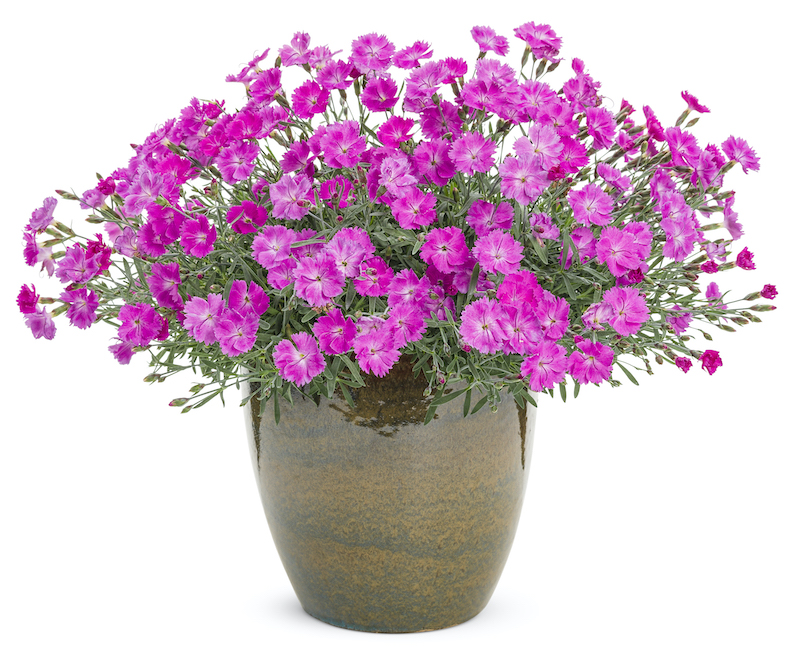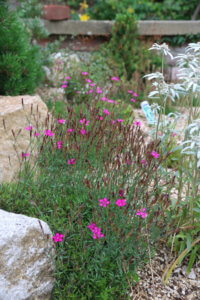Dianthus, commonly known as carnations or pinks, are beautiful flowering plants that can thrive when grown in pots. With their frilled, fragrant blooms in shades of white, pink, red and purple, dianthus make lovely additions to container gardens.
There are many reasons to grow dianthus in pots
-
Compact Varieties Many dianthus cultivars have a naturally dwarf or compact habit that lends itself perfectly to pot culture, Alpine and border pinks are smaller in stature and ideal choices,
-
Mobility: Potted dianthus can easily be moved to provide color wherever needed in a patio, balcony or yard. Pots can be positioned to capture sunlight.
-
Extend Bloom Time: Starting dianthus indoors allows you to enjoy flowers much earlier. Pots can be moved outside later.
-
Overwinter Tender Varieties: Less hardy dianthus can be grown in pots during summer and brought indoors or protected in winter.
-
Creative Designs Dianthus looks fantastic combined with other sun-loving plants in mixed potted plantings
With proper selection and care, many dianthus varieties will thrive in containers. Here’s a complete guide to growing dianthus in pots successfully:
Choosing Dianthus for Pots
When selecting dianthus for pots, opt for compact alpine, border or miniature varieties that reach 6-12 inches in height. Some good options include:
-
Arctic Fire
-
Zing Rose
-
Rose de Mai
-
First Love
-
Little Jock
-
Baby Doll
Larger dianthus varieties can also work well, provided the pot is large enough. Look for descriptions of “mounding” or “compact” habits.
Selecting the Right Pot for Dianthus
Consider the following when choosing a container for dianthus:
-
Drainage – Excellent drainage is crucial, so select pots with drainage holes. Dianthus hate wet feet.
-
Size – Choose a pot 1-2 inches wider than the nursery pot so roots have room to grow. Don’t overpot.
-
Material – Use porous terracotta, wood or plastic pots to allow air circulation to roots.
-
Shape – Match taller varieties with tall, narrow pots for best moisture control. Wider pots suit low-growing dianthus.
Fill pots with a sterile, soilless potting mix amended with sand or perlite for drainage. Avoid heavy garden soils.
How to Plant Dianthus in Pots
Planting dianthus in pots is simple:
-
Fill the container with moistened potting soil, leaving 1-2 inches below the rim.
-
Gently remove the dianthus from its nursery pot, loosening any circled roots.
-
Place the dianthus in the new pot, positioning it a bit higher than it was.
-
Backfill soil around roots, pressing firmly to eliminate air pockets.
-
Water thoroughly until it drains from the bottom. Allow room between pots for air circulation.
Caring for Dianthus in Pots
To keep potted dianthus thriving:
-
Sun – Place in full sun, ideally 6+ hours of direct sunlight daily. Morning sun is ideal.
-
Water – Check soil daily and water when the top inch is dry. Avoid overwatering.
-
Fertilizer – Use balanced liquid fertilizer every 2-3 weeks in spring through fall.
-
Deadheading – Snip off spent blooms to a leaf node to encourage reblooming.
-
Grooming – Shear back leggy growth by 1/3 to keep plants compact. Remove old foliage in fall.
-
Overwintering – Move pots to a sheltered spot outdoors or indoors in cold climates. Keep soil slightly moist.
With basic care, dianthus will prosper in pots and provide nonstop blossoms. Enjoy their colorful charm on your patio or entryway!
Troubleshooting Common Dianthus Problems
Here are some quick tips for fixing common issues with potted dianthus:
Leggy growth – Shear plants back by 1/3 to promote bushier regrowth. Ensure full sun exposure.
Few or no flowers – This is often due to overcrowding. Separate dianthus or repot into larger containers. Fertilize regularly.
Wilting – Check soil moisture and water if dry. Move to shade if in hot, midday sun.
Leaf spots – Improve air circulation. Remove affected foliage and avoid overhead watering.
Root rot – Repot in new, sterile soil. Allow soil to dry between waterings.
Insect pests – Treat aphids, thrips and other bugs with horticultural oil or insecticidal soap sprays.
Pay close attention to your potted dianthus’ needs and act promptly if any problems arise. With the right care, you’ll enjoy plentiful flowers!
Companion Plants for Dianthus Containers
Dianthus partners beautifully with other sun-loving plants in mixed containers. Some great options include:
- Catmint
- Lavender
- Rosemary
- Thyme
- Veronica
- Salvia
- Petunias
- Snapdragons
- Dusty miller
- Ornamental grasses
Create stunningcombinations by playing with colors, textures, and heights. Dianthus flowers will stand out beautifully against silver foliage like dusty miller.
Growing dianthus in pots opens up endless possibilities to enjoy these cheerful, drought-tolerant plants on your patio or balcony. With the right selection, planting and care, dianthus will thrive in containers and reward you with their fabulous flowers!

Dianthus and Reginald Farrer
First a bit of history. Reginald Farrer was a botanist and alpine collector who has no particular association with dianthus except that there were few plants that he knew nothing about and many many plants he knew much about, including dianthus.
When I want to know about a particular plant I often go to my second hand copy of his book, The English Rock Garden. This two volume tome was first published just after WWI and is a wordy but enthralling set of descriptions of mainly alpine plants and their cultivation techniques.
He didn’t let me down on dianthus. His opening paragraph confirmed what I sort of suspected – that even in Farrer’s day there was much confusion surrounding the different species and how to identify each one. Farrer says of dianthus “In no race is there more confusion and in no race is there are larger proportion of second or third rate species”.
His densely packed, wordy paragraphs contain gems of phrases and his description of Dianthus runs to 22 pages. Pity poor Dianthus cyri, written off as a “worthless wed”.
Farrer describes only species dianthus but modern breeding techniques have taken the genetics of the best of the species and bred some really beautiful and useful dianthus hybrids. Here I feature a species variety – dianthus gracilis, and then some hybrids – some named some anonymous, to show you how beautiful and useful they are in a number of garden situations.
Dianthus gracilis
 I have many attractive hummocks of D. gracilis in my rock garden, raised from seed sourced from the Alpine Garden Society seed exchange.
I have many attractive hummocks of D. gracilis in my rock garden, raised from seed sourced from the Alpine Garden Society seed exchange.
Farrer’s words on dianthus gracilis give the impression that he wasn’t massively enthralled by this particular species, although he seems to like the bright pink of the flowers. Mine are now waning in flower but have delighted me for two months or more.
Many garden pinks have very grey foliage but gracilis has fresh green leaves over which a constellation of shocking cerise flowers dance in the breeze.
Growing Dianthus Flower / Dianthus Plant Care / How to Grow Dianthus Plant in Pots
FAQ
Do Dianthus come back in pots?
Dianthus are perennials, so they will grow back every year once planted. They do tend to get a bit woody after six years or so, at which time you may want to replace them. To do this cheaply, just take cuttings from your existing plants.
How to keep Dianthus blooming all summer in pots?
A regular monthly feeding schedule after the initial planting should work for most containers, which will keep your dianthus thriving and blooming.Jun 30, 2022
How do you care for Dianthus in pots in the winter?
Watering Dianthus in Winter
Make sure the plants stay moist and do not dry out. If they are planted in containers, monitor the soil for sufficient drainage. Dianthus go dormant in the winter and do not need to be watered as much as during active growing and blooming seasons like the spring, summer and fall.
Can Dianthus be grown in containers?
Given their relatively low growing height, Dianthus look good at the front of a border. They also grow well in pots and do not mind slightly dry conditions, which containers often have. They like well-drained soil and need at least six hours of sunlight each day, so choose a sunny spot.
Can Dianthus be grown in pots?
Dianthus can thrive in containers and pots. However, be careful not to overwater them or let the soil dry out. It’s also important to ensure that the soil provides adequate drainage and the container or pot has sufficient drainage holes.
What is a Dianthus plant?
Dianthus Overview: Delve into the enchanting world of Dianthus, encompassing a diverse genus of flowering plants celebrated for their versatility and ornamental appeal. From classic carnations to modern hybrids, discover the rich botanical heritage and distinctive characteristics that make Dianthus a beloved choice among gardeners worldwide.
How do you propagate Dianthus?
Dianthus can be propagated from seeds started indoors (see planting), directly sown into the garden, or grown from stem cuttings. Make sure that the cutting has several well-developed leaf nodes. The bottom leaf node should be included in the portion of the stem dipped in the rooting hormone.
